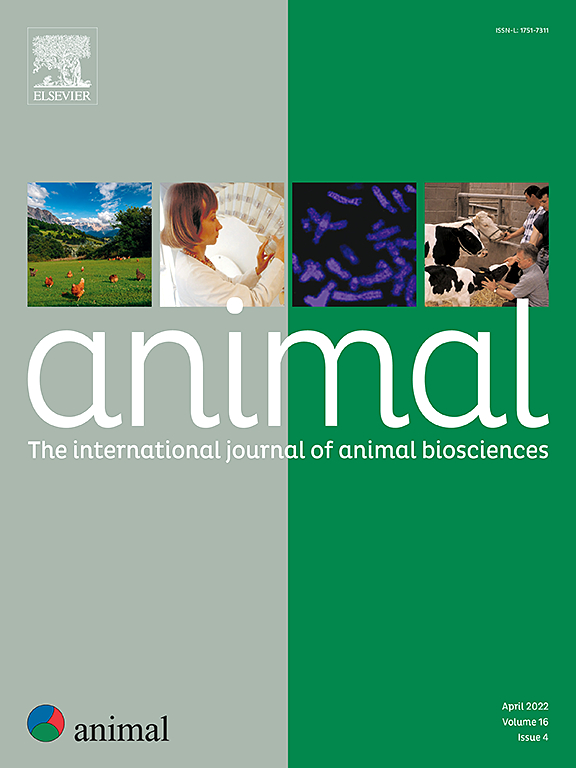Transition to selective dry cow therapy for responsible antimicrobial use in dairy cattle: a case study
IF 4.2
2区 农林科学
Q1 AGRICULTURE, DAIRY & ANIMAL SCIENCE
引用次数: 0
Abstract
Antimicrobial resistance is a major concern for public health, requiring a collective effort towards reduced antimicrobial use (AMU) across society. Major AMU in dairy cows is addressed to prevent or treat mastitis. The drying-off represents a critical time for AMU as administering antimicrobials to all quarters of all cows (blanket dry cow therapy - BDCT) is still the most adopted strategy in many countries. To reduce AMU, the European Union (EU) has banned BDCT since January 2022, and farmers were challenged to switch to selective dry cow therapy (SDCT) protocols, which entail antimicrobial treatment only to target cows with a higher risk of intramammary infection at dry-off. This study provided an overview of the practices used by Italian dairy farmers to dry off the cows when the new EU Regulation on AMU came into force. The aim was to identify the efforts required for the transition to SDCT and identify targeted actions to facilitate its success that could be applied in countries where BDCT is still allowed. An extensive survey was carried out between January and March 2022 involving 810 dairy herds rearing more than 61 000 cows. The results showed that 67% of the farmers (60% of the cows) have already adopted dry cow treatment protocols that eliminated or significantly reduced the antimicrobial therapy, whereas the remaining part still used BDCT. In SDCT farms, the mean proportion of cows receiving intramammary antimicrobials at dry-off was 43%. The SDCT farms were generally smaller in size than BDCT ones, and many SDCT farmers seemed to pay more attention to a careful management of the cows at drying-off, combining a reduced milking frequency with a change in the feeding regime to lower milk yield. The SDCT farmers most commonly used individual cow somatic cell count data to identify animals that have to receive intramammary antimicrobials at dry-off, and they declared >300 000 cells/ml the most common threshold above which a cow was targeted for antimicrobial treatment. The survey highlighted that the Italian dairy sector had already made efforts to reduce AMU at dry-off when the new EU regulation started. However, about one-third of the surveyed farms still adopted BDCT, and SDCT protocols were not well codified among different farms. Therefore, further refinements of the selection criteria for treatment allocation, supported by specific farmers’ education and training, are needed to promote a responsible AMU at the dry-off of dairy cows.
过渡到选择性干奶牛治疗负责任的抗菌素使用在奶牛:一个案例研究
抗微生物药物耐药性是公共卫生的一个主要问题,需要全社会共同努力减少抗微生物药物的使用。奶牛体内主要的乳糜泻是用来预防或治疗乳腺炎的。对AMU来说,干燥是一个关键时刻,因为对所有奶牛进行抗菌剂治疗(毯式干牛疗法- BDCT)仍然是许多国家采用最多的策略。为了减少AMU,欧盟(EU)自2022年1月起禁止使用BDCT,农民们面临着转向选择性干奶牛治疗(SDCT)方案的挑战,该方案只针对干奶牛中乳腺内感染风险较高的奶牛进行抗菌治疗。这项研究提供了意大利奶农在新的欧盟AMU法规生效时使用的做法的概述。其目的是确定向SDCT过渡所需的努力,并确定有针对性的行动,以促进其成功,这些行动可以在仍然允许BDCT的国家应用。在2022年1月至3月期间进行了一项广泛的调查,涉及饲养61000多头奶牛的810个奶牛群。结果显示,67%的农民(60%的奶牛)已经采用了消除或显著减少抗菌素治疗的干牛治疗方案,而其余部分仍然使用BDCT。在SDCT农场,奶牛在干乳时接受乳内抗菌剂的平均比例为43%。SDCT农场的规模通常比BDCT农场小,许多SDCT农民似乎更注意在奶牛干乳时仔细管理奶牛,减少挤奶频率,改变喂养方式,以降低产奶量。SDCT的农民最常使用奶牛个体体细胞计数数据来确定奶牛在干燥时必须接受乳腺内抗菌剂治疗,他们宣布30万细胞/毫升是最常见的阈值,超过这个阈值,奶牛就需要接受抗菌剂治疗。调查强调,当欧盟新法规开始实施时,意大利乳制品行业已经在努力减少干燥时的AMU。然而,大约三分之一的被调查农场仍然采用BDCT,并且不同农场之间的SDCT协议没有很好地编纂。因此,需要在特定农民的教育和培训支持下,进一步完善处理分配的选择标准,以促进奶牛脱乳时负责任的AMU。
本文章由计算机程序翻译,如有差异,请以英文原文为准。
求助全文
约1分钟内获得全文
求助全文
来源期刊

Animal
农林科学-奶制品与动物科学
CiteScore
7.50
自引率
2.80%
发文量
246
审稿时长
3 months
期刊介绍:
Editorial board
animal attracts the best research in animal biology and animal systems from across the spectrum of the agricultural, biomedical, and environmental sciences. It is the central element in an exciting collaboration between the British Society of Animal Science (BSAS), Institut National de la Recherche Agronomique (INRA) and the European Federation of Animal Science (EAAP) and represents a merging of three scientific journals: Animal Science; Animal Research; Reproduction, Nutrition, Development. animal publishes original cutting-edge research, ''hot'' topics and horizon-scanning reviews on animal-related aspects of the life sciences at the molecular, cellular, organ, whole animal and production system levels. The main subject areas include: breeding and genetics; nutrition; physiology and functional biology of systems; behaviour, health and welfare; farming systems, environmental impact and climate change; product quality, human health and well-being. Animal models and papers dealing with the integration of research between these topics and their impact on the environment and people are particularly welcome.
 求助内容:
求助内容: 应助结果提醒方式:
应助结果提醒方式:


